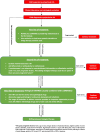African guidelines for diagnosis and management of polyarticular juvenile idiopathic arthritis: PAFLAR initiative
- PMID: 40089767
- PMCID: PMC11909873
- DOI: 10.1186/s12969-025-01076-5
African guidelines for diagnosis and management of polyarticular juvenile idiopathic arthritis: PAFLAR initiative
Abstract
Background: Juvenile idiopathic arthritis (JIA) is the most common rheumatologic disease of childhood. The Existing guidelines for polyarticular JIA are typically based on data from non-African populations and may not fully address the unique challenges faced in African settings. We aimed to produce updated African guidelines for the diagnosis and treatment of children and adolescents with polyarticular juvenile idiopathic arthritis (poly-JIA).
Methods: This study was conducted with the aim of reaching a consensus among African experts on the diagnosis and treatment of poly-JIA using the Delphi technique. The first scientific committee identified a total of 15 key clinical questions according to the PICO (Patient/Population, Intervention, Comparison, Outcome) approach. A systematic review of the evidence-based literature was conducted for this work. The core steering group identified researchers and clinicians with expertise in pediatric rheumatology. A Delphi process was used to reach consensus.
Results: An online questionnaire was sent to the expert panel that participated in the survey (100% response rate). A total of 15 recommendation points were identified, divided into two parts: five recommendations for diagnosis and ten recommendations for management. The percentage of those who agreed with the recommendations (fourth and fifth place) ranged from 80 to 100%. All 15 clinical recommendation statements that the scientific committee had identified had been agreed upon in wording (i.e., 75% of respondents agreed or strongly agreed).
Conclusions: We successfully developed guidelines for children with polyarticular JIA, taking into consideration the African specific nature of limited resources and low income, also on the same time incorporating newly released data and using a treat to target approach.
Keywords: Africa; Guidelines; JIA; PAFLAR; Pediatric; Polyarticular JIA.
© 2025. The Author(s).
Conflict of interest statement
Declarations. Ethics approval and consent to participate: Not applicable. Consent for publication: Not applicable. Competing of interests: The authors declare no competing interests.
Figures
References
-
- Rose E, Petty TRS, Manners P, et al. International league of associations for rheumatology classification of juvenile idiopathic arthritis: second revision, Edmonton, 2001. J Rheumatol. 2004;2:390–2. - PubMed
-
- Martini A, Lovell DJ, Albani S, et al. Juvenile idiopathic arthritis. Nat Rev Dis Primers. 2022;8(1):5. - PubMed
-
- Alian SM, Esmail HA, Gabr MM, et al. Predictors of subclinical cardiovascular affection in Egyptian patients with juvenile idiopathic arthritis subtypes. Egypt Rheumatol Rehabil. 2020;47:6.
MeSH terms
Substances
LinkOut - more resources
Full Text Sources
Medical


